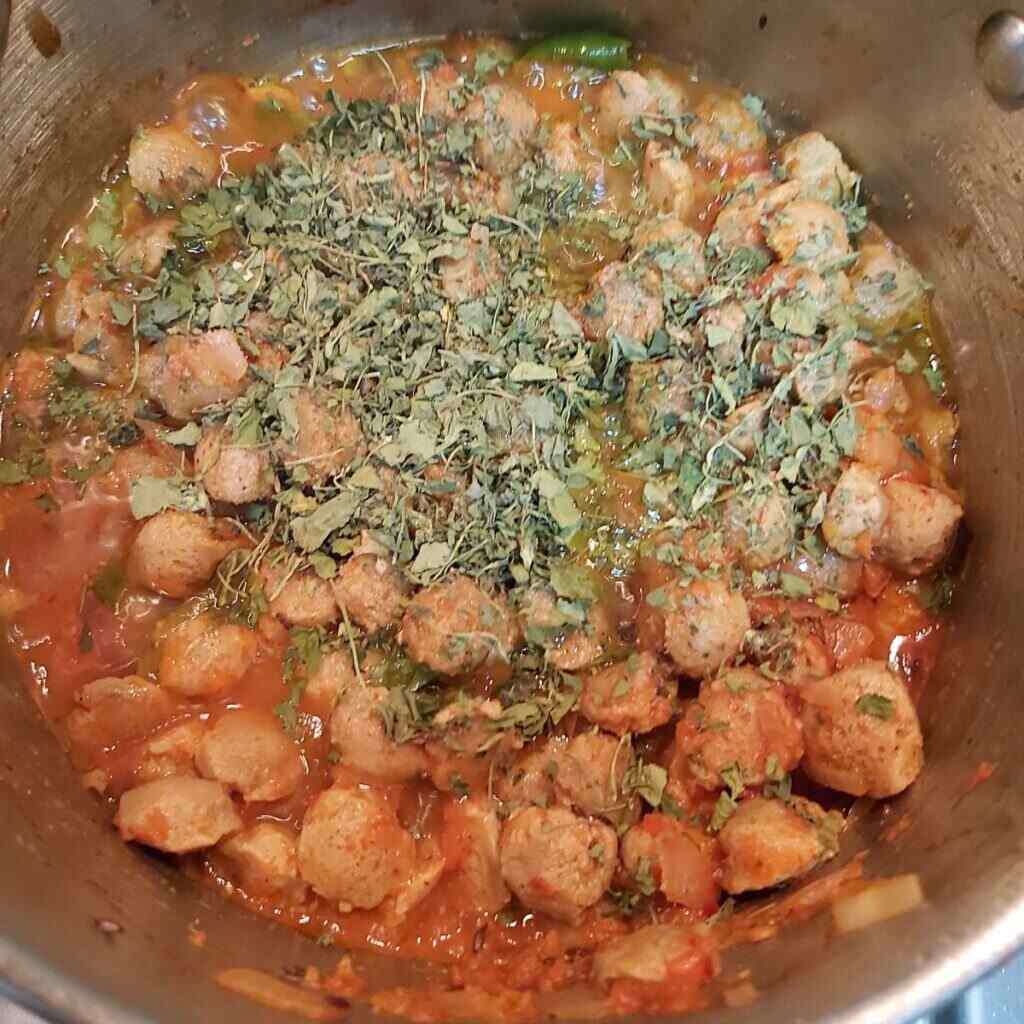Soya Chunks Fenugreek Leaves Curry is a delightful vegetarian dish that combines the goodness of protein-rich soya chunks with the aromatic flavor of fenugreek leaves. Commonly prepared in Indian cuisine, this curry offers a balanced blend of textures and tastes, with the soya chunks providing a meaty texture and the fenugreek leaves adding a unique, slightly bitter flavor profile. This dish is not only delicious but also nutritious, making it a popular choice for those seeking a wholesome and satisfying meal.
| Ingredients | |
| 1 | 1 cup soya chunks |
| 2 | 1 bunch fresh fenugreek leaves (or 1 cup dried fenugreek leaves) |
| 3 | 2 medium-sized onions, finely chopped |
| 4 | 2 tomatoes, finely chopped |
| 5 | 3-4 cloves of garlic, minced |
| 6 | 1-inch piece of ginger, grated |
| 7 | 2 green chilies, slit lengthwise |
| 8 | 1 teaspoon cumin seeds |
| 9 | 1 teaspoon coriander powder |
| 10 | 1/2 teaspoon turmeric powder |
| 11 | Half a teaspoon of red chili powder, or to taste |
| 12 | Salt to taste |
| 13 | 2 tablespoons cooking oil |
| 14 | Water as needed |
Step-by-step cooking instruction of Soya Chunks Fenugreek Leaves Curry:
Step-1 Prepare the Soya Chunks:
- Place the soya chunks in a bowl and cover them with hot water. Let them soak for about 15-20 minutes or until they become soft and double in size.
- Once soaked, drain the water from the soya chunks and squeeze out excess water. Set aside.
Step-2 Prepare the Fenugreek Leaves:
- Wash the fresh fenugreek leaves well under running water to get rid of any dirt or contaminants. Finely chop them and place them aside.
- If using dried fenugreek leaves (kasturi methi), crush them slightly between your palms and set aside.
Step-3 Cook the Curry:
- In a pan or kadhai, warm the oil over medium heat. Sprinkle in the cumin seeds and watch them pop.
- Include chopped onions and cook until they take on a golden brown color.
- Stir in the grated ginger, minced garlic, and sliced green chilies. Cook for a few more minutes, or until the raw scent goes away.
- Now, add chopped tomatoes and cook until they turn mushy and oil starts to separate from the masala.
- Oil should be heated over medium heat in a pan or kadhai. Add the cumin seeds and splutter them.
Step-4 Add Soya Chunks and Fenugreek Leaves:
- Squeeze and soak the soya chunks before adding them to the pan. Well combine them with the masala.
- If using fresh fenugreek leaves, add them at this stage. If using dried fenugreek leaves, add them later in the cooking process.
- To modify the curry’s consistency, add water as needed. Cover the pan and let it simmer for 8-10 minutes, allowing the flavors to meld together.
Step-5 Garnish and Serve:
- Once the soya chunks are cooked and the curry reaches the desired consistency, check for seasoning and adjust if necessary.
- Garnish with fresh coriander leaves.
- Serve hot with steamed rice or Indian breads like roti or naan.
Nutritional values of Soya Chunks Fenugreek Leaves Curry:
The nutritional value of Soya Chunks Fenugreek Leaves Curry can vary slightly based on specific ingredients and cooking methods. However, Here is a broad summary of the nutritional advantages, though:
| 1 | Protein: Soya chunks are highly nutritious and rich in protein, making them an excellent plant-based source of this essential nutrient. They contribute significantly to the protein content of the curry, aiding in muscle repair and growth. |
| 2 | Fiber: Fenugreek leaves are a good source of dietary fiber, which is essential for digestive health. The fiber content in the curry helps promote satiety, regulate blood sugar levels, and support a healthy digestive system. |
| 3 | Vitamins and Minerals: Iron, magnesium, manganese, and vitamins A and C are among the many vitamins and minerals found in fenugreek leaves. These nutrients play various roles in maintaining overall health, including supporting immune function, bone health, and energy metabolism. |
| 4 | Low in Calories: Soya Chunks Fenugreek Leaves Curry can be a relatively low-calorie dish, especially when prepared with minimal oil and served with healthy accompaniments like steamed rice or whole wheat roti. |
| 5 | Antioxidants: Fenugreek leaves contain antioxidants such as flavonoids and polyphenols, which help protect cells from oxidative damage caused by free radicals. Including fenugreek leaves in the curry adds an antioxidant boost to the dish. |
| 6 | Healthy Fats: When cooked with minimal oil or healthy cooking fats like olive oil, the curry provides essential fatty acids that support heart health and nutrient absorption. |
Background History of Soya Chunks Fenugreek Leaves Curry
The history of Soya Chunks Fenugreek Leaves Curry is deeply intertwined with the culinary traditions of India, where both soya chunks and fenugreek leaves have been staples for centuries.
Soya Chunks: Soybeans, the primary ingredient in soya chunks, have been cultivated in Asia for thousands of years. Soybeans were traditionally utilized in Indian cuisine to manufacture a variety of meals, such as tofu, tempeh, and soy milk. Soya chunks, also known as textured vegetable protein (TVP) or soy meat, emerged as a convenient and versatile meat substitute in vegetarian cuisine, particularly in the latter half of the 20th century. Their affordability, high protein content, and neutral flavor made them popular among vegetarian households and those looking to reduce meat consumption.
Fenugreek Leaves: Fenugreek, or methi, has been cultivated in the Indian subcontinent for its culinary and medicinal properties since ancient times. The leaves, seeds, and sprouts of fenugreek are widely used in Indian cooking, adding flavor, aroma, and nutritional value to various dishes. Fenugreek leaves are known for their slightly bitter taste and distinct aroma, which pairs well with spices and other ingredients in Indian curries and stir-fries.
The combination of soya chunks and fenugreek leaves in a curry likely evolved as a way to enhance the nutritional profile and flavor of vegetarian dishes. The meaty texture of soya chunks complements the earthy bitterness of fenugreek leaves, creating a balanced and satisfying dish that appeals to both vegetarians and non-vegetarians.
Over time, Soya Chunks Fenugreek Leaves Curry has become a popular dish in Indian households and restaurants, offering a nutritious and flavorful alternative to meat-based curries. Its versatility allows for various adaptations and regional variations, reflecting the diverse culinary landscape of India.
Today, Soya Chunks Fenugreek Leaves Curry remains a beloved dish cherished for its taste, texture, and nutritional benefits, continuing to be enjoyed by people across India and beyond.
| Advantages of Soya Chunks Fenugreek Leaves Curry | |
| 1 | High Nutritional Value: Soya chunks are rich in protein, while fenugreek leaves provide essential vitamins and minerals, making this curry a nutritious option. |
| 2 | Vegetarian Protein Source: Ideal for vegetarians and vegans, this dish offers a meat-free protein alternative through soya chunks. |
| 3 | Fiber-Rich: Fenugreek leaves contribute to the fiber content of the dish, promoting digestive health and aiding in satiety. |
| 4 | Balanced Flavor Profile: The combination of soya chunks and fenugreek leaves offers a balance of textures and flavors, resulting in a satisfying and flavorful dish. |
| Versatility: This curry can be adapted to personal taste preferences and dietary requirements by adjusting the spices and ingredients. | |
| 6 | Cost-Effective: Soya chunks and fenugreek leaves are often affordable ingredients, making this dish budget-friendly for households. |
| Disadvantages of Soya Chunks Fenugreek Leaves Curry | |
| 1 | Bitterness of Fenugreek: Some individuals may find the bitterness of fenugreek leaves overpowering or unpleasant, impacting their enjoyment of the dish. |
| 2 | Allergies or Sensitivities: People with soy allergies or sensitivities may need to avoid soya chunks, limiting the suitability of this dish for certain individuals. |
| 3 | Potential Digestive Issues: Excessive consumption of fenugreek leaves may cause digestive discomfort for some individuals, particularly if they are not accustomed to consuming them regularly. |
| 4 | High Sodium Content: Depending on the preparation method, Soya Chunks Fenugreek Leaves Curry may contain high levels of sodium, especially if store-bought spice blends or sauces are used. |
| 5 | Texture of Soya Chunks: While some enjoy the meaty texture of soya chunks, others may find it less appealing or unfamiliar, affecting their overall satisfaction with the dish. |
| 6 | Cultural Preferences: This dish may not appeal to everyone due to cultural differences or personal taste preferences, limiting its acceptance in some households or communities. |
Compare with Similar meal of Soya Chunks Fenugreek Leaves Curry:
Similar meals to Soya Chunks Fenugreek Leaves Curry include dishes that combine protein-rich ingredients with flavorful herbs and spices. Here are a few options:
| 1 | Soya Chunks Spinach Curry: Substitute fenugreek leaves with fresh spinach leaves to create a nutritious and flavorful curry. Spinach provides a milder flavor compared to fenugreek leaves but offers similar nutritional benefits. |
| 2 | Soya Chunks Capsicum Curry: Combine soya chunks with bell peppers (capsicum) to create a colorful and nutritious curry. The sweetness of the capsicum complements the savory flavor of the soya chunks, resulting in a delicious dish. |
| 3 | Soya Chunks Mushroom Curry: Add mushrooms to soya chunks curry for an extra boost of flavor and texture. Mushrooms provide an earthy taste and meaty texture, enhancing the overall richness of the curry. |
| 4 | Soya Chunks Coconut Curry: Prepare a creamy coconut curry using soya chunks as the main protein source. Coconut milk adds richness and sweetness to the dish, while spices like curry leaves and mustard seeds impart a distinct South Indian flavor. |
| 5 | Soya Chunks Tomato Curry: Create a tangy tomato-based curry using soya chunks as the protein component. Tomatoes add acidity and depth to the curry, while spices like garam masala and fenugreek seeds enhance the flavor profile. |
| 6 | Soya Chunks Lentil Curry: Combine soya chunks with lentils (such as red lentils or split chickpeas) to create a hearty and nutritious curry. Lentils provide additional protein and fiber, making the dish more filling and satisfying. |
Mostly questions asked about Soya Chunks Fenugreek Leaves Curry
1: What are soya chunks?
A: Soya chunks are a textured vegetable protein made from defatted soy flour. They are a popular meat substitute in vegetarian and vegan cooking due to their high protein content and meat-like texture.
2: What are fenugreek leaves?
A: The foliage of the fenugreek plant is referred to as methi leaves, or fenugreek leaves. They have a slightly bitter taste and are commonly used as a culinary herb in Indian cuisine.
3: Is Soya Chunks Fenugreek Leaves Curry vegetarian?
A: Yes, Soya Chunks Fenugreek Leaves Curry is a vegetarian dish as it does not contain any meat or animal-derived ingredients.
4: How do you prepare soya chunks for the curry?
A: Soak the soya chunks in hot water for about 15-20 minutes until they soften, then drain and squeeze out excess water before adding them to the curry.
5: Can I use dried fenugreek leaves instead of fresh?
A: Yes, you can substitute dried fenugreek leaves (kasturi methi) for fresh fenugreek leaves. Crush them slightly between your palms before adding them to the curry.
6: Is Soya Chunks Fenugreek Leaves Curry spicy?
A: You can change the level of spiciness to suit your own tastes. Typically, it is mildly spiced, but you can increase or decrease the amount of chili powder or green chilies to suit your taste.
7: How long does it take to cook Soya Chunks Fenugreek Leaves Curry?
A: It takes approximately 30-40 minutes to prepare Soya Chunks Fenugreek Leaves Curry, including soaking the soya chunks and cooking the curry.
8: Can I freeze Soya Chunks Fenugreek Leaves Curry?
A: Yes, you can freeze leftover Soya Chunks Fenugreek Leaves Curry in an airtight container for up to 2-3 months. Thaw in the refrigerator before reheating.
9: What can I serve with Soya Chunks Fenugreek Leaves Curry?
A: Soya Chunks Fenugreek Leaves Curry pairs well with steamed rice, roti, naan, or any other Indian bread.
10: Is Soya Chunks Fenugreek Leaves Curry healthy?
A: Yes, Soya Chunks Fenugreek Leaves Curry is a nutritious dish as it contains protein-rich soya chunks, fiber-rich fenugreek leaves, and a variety of spices that offer health benefits. However, the overall healthiness may depend on the cooking method and ingredients used.







